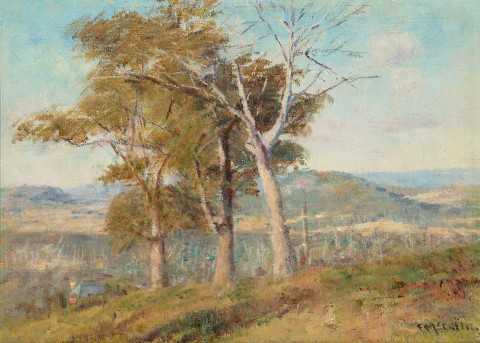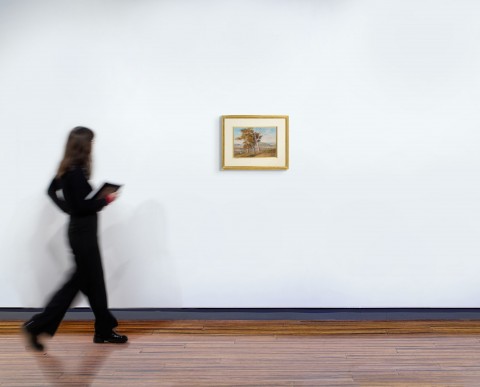LANDSCAPE (MOUNT MACEDON)
FREDERICK McCUBBIN
oil on canvas on plywood
25.0 x 35.5 cm
signed lower right: F McCubbin
Private collection, Melbourne
In September 1901, Frederick McCubbin and his wife Annie purchased Fontainebleau, a two-storey gabled cottage in Glover Road on the slopes of Mount Macedon. The family maintained a residence in the city but spent a large part of their time at this country retreat located on the traditional lands of the Dja Dja Wurrung, Taungurung and Wurundjeri Woi Wurrung peoples. According to McCubbin’s daughter Kathleen, her father’s ‘greatest love was the bushland at Mt Macedon. The mystique of the Australian bushland intrigued him: the sunlight glinting through the tall timbers, the secret colours in the abundant undergrowth, the call of the birds, and the whispering breeze… He loved them all.’1 Landscape (Mount Macedon) was painted on the hill behind Fontainebleau and shows the rise of the former volcano Hanging Rock (Ngannelong) to the right, a view similar to that seen from the top-floor bedrooms of the cottage. To the left is a glimpse of one of Fontainebleau’s two chimneys and in between are the plains dotted with dead trees, likely strip bark as the land was being cleared for sheep and cattle.
From the late 1880s, McCubbin and his colleagues Arthur Streeton and Tom Roberts were acclaimed for their new interpretation of the Australian bush, with McCubbin specialising in large narrative paintings depicting colonial settlers, such as The bush burial, 1890 (Geelong Art Gallery) and the iconic Down on his luck, 1889 (Art Gallery of Western Australia). At Mount Macedon, he completed the final – and largest – of these, the monumental triptych The pioneer, 1904 (National Gallery of Victoria), the second panel of which shows a small cottage located on William McGregor’s property behind Fontainebleau called ‘Ard choile’ meaning ‘height of the woods’. Given the raised aspect, it is plausible that Landscape (Mount Macedon) was painted near this cottage, although this particular view is no longer attainable due to tree growth. Following The pioneer, McCubbin wrote to Streeton that ‘I am afraid I must paint smaller pictures for the future (on little stretchers eight by ten, I laid him and his brethren)’2, and in a letter to Tom Roberts the following year, he further notes that he has again returned from ‘the Mount’ with a series of small studies.3
In May 1907, McCubbin travelled to Europe for three months and spent much of his time there studying the work of significant painters including J.M.W. Turner and Claude Monet, whose techniques he then sought to absorb into his own work. Although undated, it is possible that Landscape (Mount Macedon) was painted shortly after his return, with the distinctive flickering edging of the trees echoing that seen in other contemporaneous works such as Winter sunlight, 1908 (Art Gallery of South Australia). Regardless of date, this is a charming and serene view of a landscape undergoing pastoral change, rich with ‘the soft tender violet gold grey of the gums’4 that McCubbin loved so well.
1. Mangan, K., Daisy chains, war, the jazz, Hutchison, Melbourne, 1984, p. 70
2. Frederick McCubbin, letter to Arthur Streeton, 4 September 1904, cited in McKenzie, A., Frederick McCubbin 1855 – 1917: ‘The Proff’ and his art, Mannagum Press, Melbourne, 1990, p. 236. McCubbin repeated the line ‘on little stretchers eight by ten, I laid him and his brethren’ in a letter to Tom Roberts 7 November 1904 (see p. 237) but the source of this quote is unknown.
3. Frederick McCubbin, letter to Tom Roberts, 25 August 1905, cited in McKenzie, ibid., p. 240
4. Frederick McCubbin, letter to Tom Roberts, November 1903, cited in Whitelaw, B., The art of Frederick McCubbin, National Gallery of Victoria, Melbourne, 1991, p. 6
ANDREW GAYNOR


